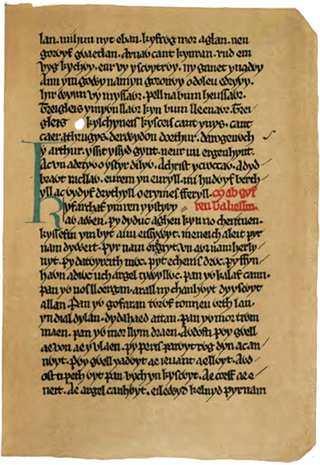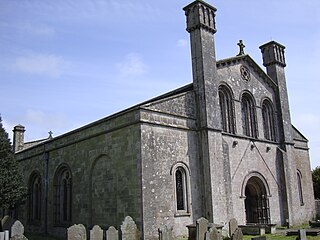
The Mabinogion are the earliest Welsh prose stories, and belong to the Matter of Britain. The stories were compiled in Middle Welsh in the 12th–13th centuries from earlier oral traditions. There are two main source manuscripts, created c. 1350–1410, as well as a few earlier fragments. The title covers a collection of eleven prose stories of widely different types, offering drama, philosophy, romance, tragedy, fantasy and humour, and created by various narrators over time. There is a classic hero quest, "Culhwch and Olwen"; a historic legend in "Lludd and Llefelys", complete with glimpses of a far off age; and other tales portray a very different King Arthur from the later popular versions. The highly sophisticated complexity of the Four Branches of the Mabinogi defies categorisation. The stories are so diverse that it has been argued that they are not even a true collection.

William Salesbury, also Salusbury, was the leading Welsh scholar of the Renaissance and the principal translator of the 1567 Welsh New Testament.

In Christianity, an anchorite or anchoret is someone who, for religious reasons, withdraws from secular society to be able to lead an intensely prayer-oriented, ascetic, or Eucharist-focused life. Anchorites are frequently considered to be a type of hermit, but unlike hermits, they were required to take a vow of stability of place, opting for permanent enclosure in cells often attached to churches. Also unlike hermits, anchorites were subject to a religious rite of consecration that closely resembled the funeral rite, following which they would be considered dead to the world and a type of living saint. Anchorites had a certain autonomy, as they did not answer to any ecclesiastical authority apart from bishops.
Dyfnwal Moelmud was accounted as an early king and lawmaker among the Welsh, credited with the codification of their standard units of measure. He also figures as a legendary king of the Britons in Geoffrey of Monmouth's pseudohistorical History of the Kings of the Britons.

The Red Book of Hergest, Oxford, Jesus College, MS 111, is a large vellum manuscript written shortly after 1382, which ranks as one of the most important medieval manuscripts written in the Welsh language. It preserves a collection of Welsh prose and poetry, notably the tales of the Mabinogion and Gogynfeirdd poetry. The manuscript derives its name from the colour of its leather binding and from its association with Hergest Court between the late 15th and early 17th century.

Sir John Morris-Jones was a Welsh grammarian, academic and Welsh-language poet.

Ancrene Wisse is an anonymous monastic rule for female anchoresses written in the early 13th century.

The Black Book of Carmarthen is thought to be the earliest surviving manuscript written solely in Welsh. The book dates from the mid-13th century; its name comes from its association with the Priory of St. John the Evangelist and Teulyddog at Carmarthen, and is referred to as black due to the colour of its binding. It is currently part of the collection of the National Library of Wales, where it is catalogued as NLW Peniarth MS 1.

The Book of Taliesin is one of the most famous of Middle Welsh manuscripts, dating from the first half of the 14th century though many of the fifty-six poems it preserves are taken to originate in the 10th century or before.
Medieval Welsh literature is the literature written in the Welsh language during the Middle Ages. This includes material starting from the 5th century AD, when Welsh was in the process of becoming distinct from Common Brittonic, and continuing to the works of the 16th century.

Sir John Rhŷs, was a Welsh scholar, fellow of the British Academy, Celticist and the first professor of Celtic at Oxford University.

The Book of Llandaff, is the cartulary of the cathedral of Llandaff, a 12th-century compilation of documents relating to the history of the diocese of Llandaff in Wales. It is written primarily in Latin but also contains a significant amount of Old and Middle Welsh names and marginalia.
Bledric ap Custennin was a 6th- and 7th-century ruler of Dumnonia.

Brut y Brenhinedd is a collection of variant Middle Welsh versions of Geoffrey of Monmouth's Latin Historia Regum Britanniae. About 60 versions survive, with the earliest dating to the mid-13th century. Adaptations of Geoffrey's Historia were extremely popular throughout Western Europe during the Middle Ages, but the Brut proved especially influential in medieval Wales, where it was largely regarded as an accurate account of the early history of the Celtic Britons.

The White Book of Hergest was an important Welsh manuscript compiled in c. 1450. It contained many Welsh poems and prose texts and was a significant source for several antiquaries of the 17th and 18th centuries, but disappeared in the early 19th century, probably being destroyed in a fire in a London bookbinder's shop in around 1810.
The Black Book of Chirk is a 13th-century Welsh-language manuscript, known also as the Chirk Codex. It is Peniarth 29 of the National Library of Wales, and deals with legal and historical matters. It contains also an elegy addressed at Llywelyn ap Iorwerth; king of Wales. This poem was probably written by his grandson Llywelyn ap Gruffudd who lived in the 13th century.
Wales has produced a number of manuscripts over the centuries. Although most were written in Middle Welsh or Old Welsh, some were also written in Latin. In some of the more recent manuscripts it is not uncommon to have texts in Welsh, Latin, French and English in the same volume. However, some of the most important medieval manuscripts were written in Latin only, e.g. the Cyfraith Hywel.
St David's Church is a Grade II* listed medieval church in the Welsh village of Llanddewi Brefi, 3 miles south of Tregaron in the county of Ceredigion.
Thomas Wiliems was a Welsh-language antiquarian.
"Y Llafurwr", known in English as "The Ploughman" or "The Labourer", is a poem in the form of a cywydd by the 14th-century Welsh poet Iolo Goch. Often compared with William Langland's Middle English Piers Plowman, it presents a sympathetic portrayal of the meek and godly ploughman; no other Welsh bardic poem takes an ordinary working man as its subject. It has been called the most notable of Iolo's poems, comparable with the finest works of Dafydd ap Gwilym, and its popularity in the Middle Ages can be judged from the fact that it survives in seventy-five manuscripts. It is included in The Oxford Book of Welsh Verse.












